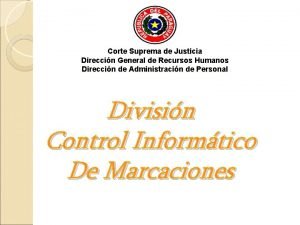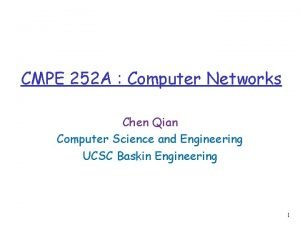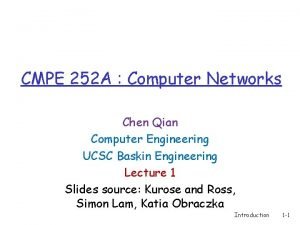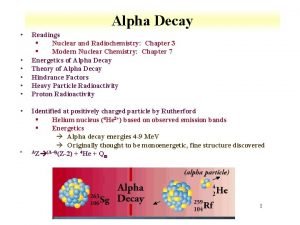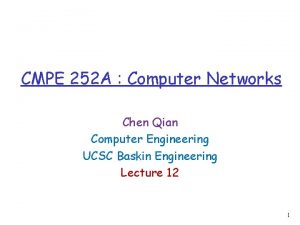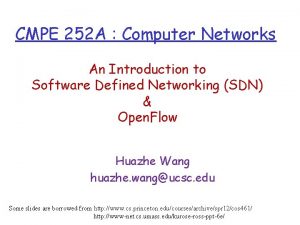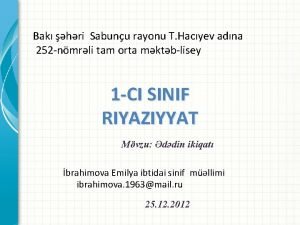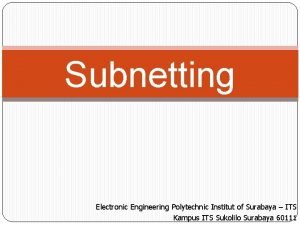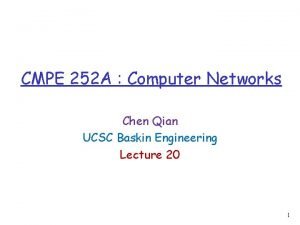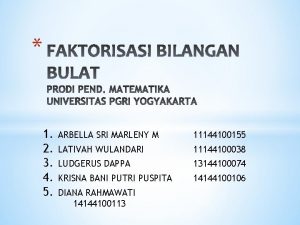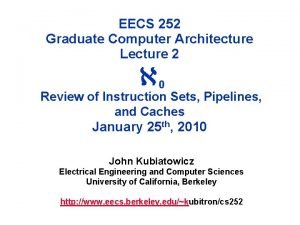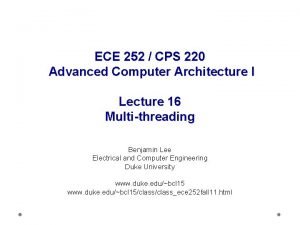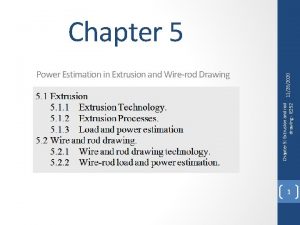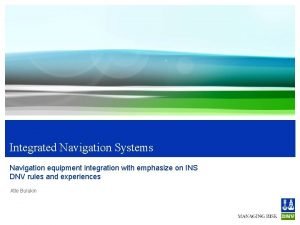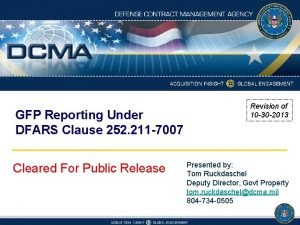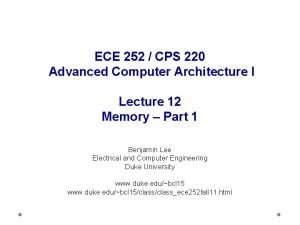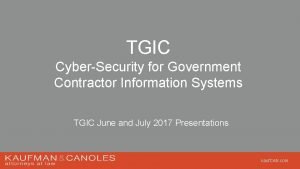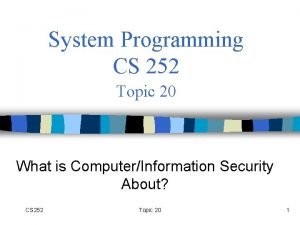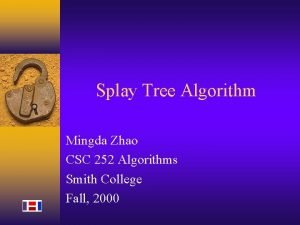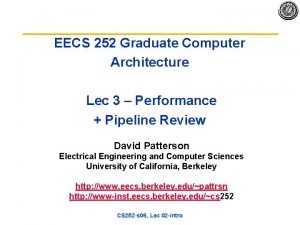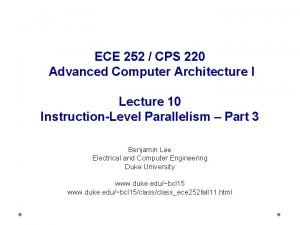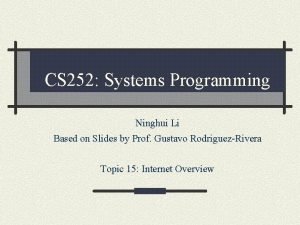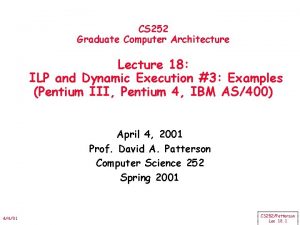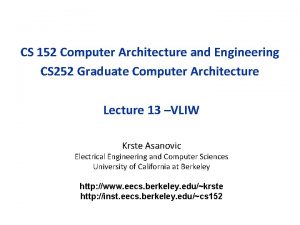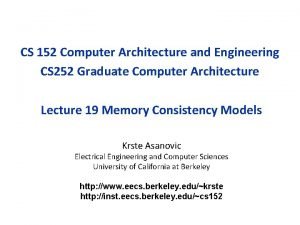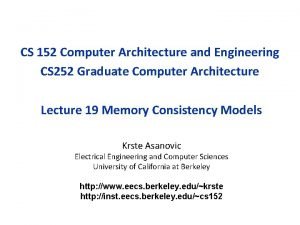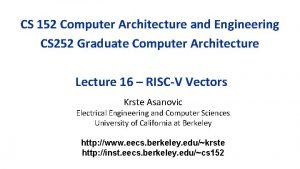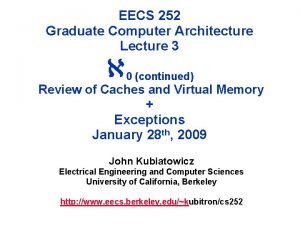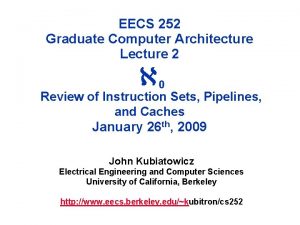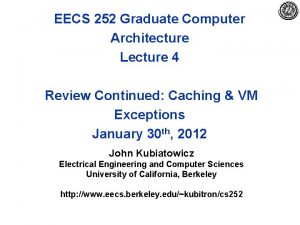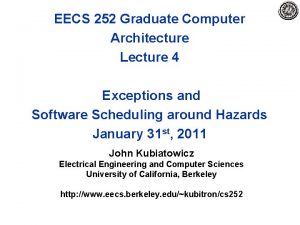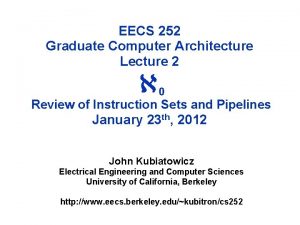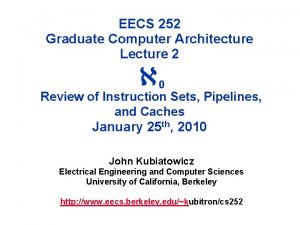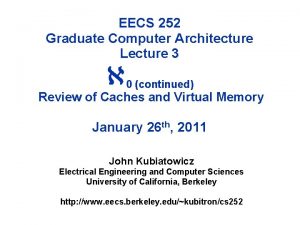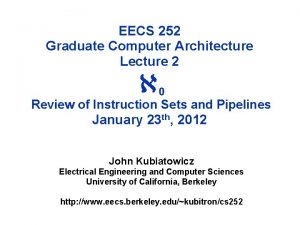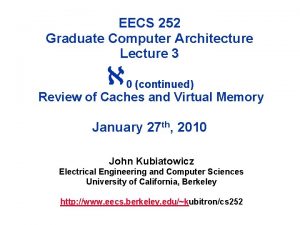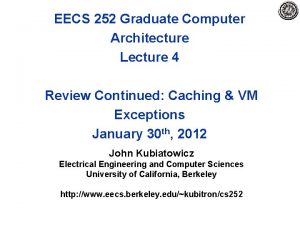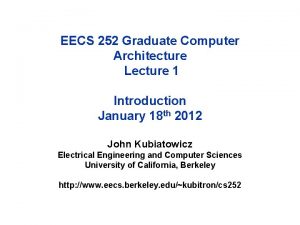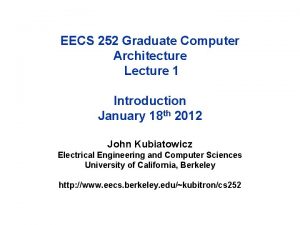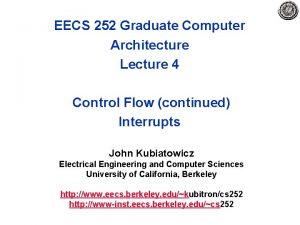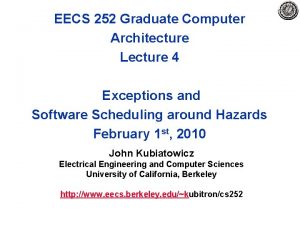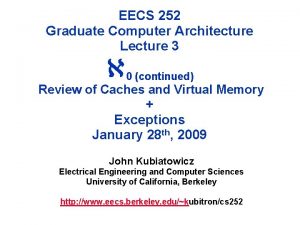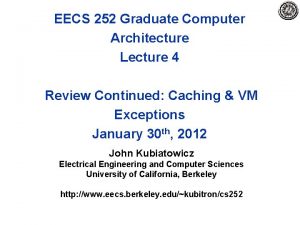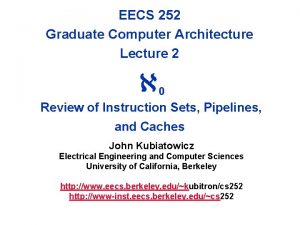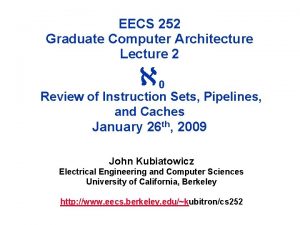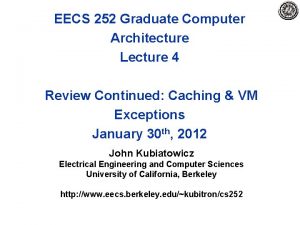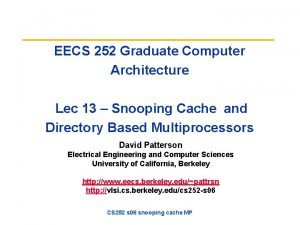EECS 252 Graduate Computer Architecture Lecture 2 0




























































- Slides: 60

EECS 252 Graduate Computer Architecture Lecture 2 0 Review of Instruction Sets, Pipelines, and Caches January 24 th, 2011 John Kubiatowicz Electrical Engineering and Computer Sciences University of California, Berkeley http: //www. eecs. berkeley. edu/~kubitron/cs 252

Review: Moore’s Law • “Cramming More Components onto Integrated Circuits” – Gordon Moore, Electronics, 1965 • 1/24/2011 # on transistors on cost effective integrated circuit double every 18 months CS 252 -S 11, Lecture 02 2

Review: Limiting Forces • Chip density is continuing increase ~2 x every 2 years Source: Intel, Microsoft (Sutter) and Stanford (Olukotun, Hammond) – Clock speed is not – # processors/chip (cores) may double instead • There is little or no more Instruction Level Parallelism (ILP) to be found – Can no longer allow programmer to think in terms of a serial programming model • Conclusion: Parallelism must be exposed to software! 1/19/2011 CS 252 -S 11, Lecture 01 3

Examples of MIMD Machines • Symmetric Multiprocessor – Multiple processors in box with shared memory communication – Current Multi. Core chips like this – Every processor runs copy of OS • Non uniform shared memory with separate I/O through host – Multiple processors » Each with local memory » general scalable network – Extremely light “OS” on node provides simple services » Scheduling/synchronization – Network accessible host for I/O P P Bus Memory P/M P/M Host P/M P/M • Cluster – Many independent machine connected with general network – Communication through messages 1/19/2011 CS 252 -S 11, Lecture 01 4

Time (processor cycle) Categories of Thread Execution Superscalar Simultaneous Fine Grained. Coarse Grained. Multiprocessing. Multithreading Thread 1 Thread 2 1/19/2011 Thread 3 Thread 4 CS 252 -S 11, Lecture 01 Thread 5 Idle slot 5

log (people per computer) “Bell’s Law” – new class per decade Number Crunching Data Storage productivity interactive • Enabled by technological opportunities streaming information to/from physical world year • Smaller, more numerous and more intimately connected • Brings in a new kind of application • Used in many ways not previously imagined 1/24/2011 CS 252 -S 11, Lecture 02 6

Today: Quick review of everything you should have learned 0 ( A countably infinite set of computer architecture concepts ) 1/24/2011 CS 252 -S 11, Lecture 02 7

Metrics used to Compare Designs • Cost – Die cost and system cost • Execution Time – average and worst case – Latency vs. Throughput • Energy and Power – Also peak power and peak switching current • Reliability – Resiliency to electrical noise, part failure – Robustness to bad software, operator error • Maintainability – System administration costs • Compatibility – Software costs dominate 1/24/2011 CS 252 -S 11, Lecture 02 8

What is Performance? • Latency (or response time or execution time) – time to complete one task • Bandwidth (or throughput) – tasks completed per unit time 1/24/2011 CS 252 -S 11, Lecture 02 9

Definition: Performance • Performance is in units of things per sec – bigger is better • If we are primarily concerned with response time performance(x) = 1 execution_time(x) " X is n times faster than Y" means Performance(X) n = Performance(Y) 1/24/2011 Execution_time(Y) = Execution_time(X) CS 252 -S 11, Lecture 02 10

Performance: What to measure • Usually rely on benchmarks vs. real workloads • To increase predictability, collections of benchmark applications benchmark suites are popular • SPECCPU: popular desktop benchmark suite – – CPU only, split between integer and floating point programs SPECint 2000 has 12 integer, SPECfp 2000 has 14 integer pgms SPECCPU 2006 to be announced Spring 2006 SPECSFS (NFS file server) and SPECWeb (Web. Server) added as server benchmarks • Transaction Processing Council measures server performance and cost performance for databases – – 1/24/2011 TPC C Complex query for Online Transaction Processing TPC H models ad hoc decision support TPC W a transactional web benchmark TPC App application server and web services benchmark CS 252 -S 11, Lecture 02 11

Summarizing Performance System Rate (Task 1) Rate (Task 2) A 10 20 B 20 10 Which system is faster? 1/24/2011 CS 252 -S 11, Lecture 02 12

… depends who’s selling System Rate (Task 1) Rate (Task 2) Average A 10 20 15 B 20 10 15 Average throughput System Rate (Task 1) Rate (Task 2) Average A 0. 50 2. 00 1. 25 B 1. 00 Throughput relative to B System Rate (Task 1) Rate (Task 2) Average A 1. 00 B 2. 00 0. 50 1. 25 Throughput relative to A 1/24/2011 CS 252 -S 11, Lecture 02 13

Summarizing Performance over Set of Benchmark Programs • 1/24/2011 CS 252 -S 11, Lecture 02 14

Normalized Execution Time and Geometric Mean • 1/24/2011 CS 252 -S 11, Lecture 02 15

Vector/Superscalar Speedup • 100 MHz Cray J 90 vector machine versus 300 MHz Alpha 21164 • [LANL Computational Physics Codes, Wasserman, ICS’ 96] • Vector machine peaks on a few codes? ? 1/24/2011 CS 252 -S 11, Lecture 02 16

Superscalar/Vector Speedup • 100 MHz Cray J 90 vector machine versus 300 MHz Alpha 21164 • [LANL Computational Physics Codes, Wasserman, ICS’ 96] • Scalar machine peaks on one code? ? ? 1/24/2011 CS 252 -S 11, Lecture 02 17

How to Mislead with Performance Reports • • • Select pieces of workload that work well on your design, ignore others Use unrealistic data set sizes for application (too big or too small) Report throughput numbers for a latency benchmark Report latency numbers for a throughput benchmark Report performance on a kernel and claim it represents an entire application • Use 16 bit fixed point arithmetic (because it’s fastest on your system) even though application requires 64 bit floating point arithmetic • Use a less efficient algorithm on the competing machine • Report speedup for an inefficient algorithm (bubblesort) • Compare hand optimized assembly code with unoptimized C code • Compare your design using next year’s technology against competitor’s year old design (1% performance improvement per week) • Ignore the relative cost of the systems being compared • Report averages and not individual results • Report speedup over unspecified base system, not absolute times • Report efficiency not absolute times • Report MFLOPS not absolute times (use inefficient algorithm) [ David Bailey “Twelve ways to fool the masses when giving performance results for parallel supercomputers” ] 1/24/2011 CS 252 -S 11, Lecture 02 18

CS 252 Administrivia • Sign up! Web site is: http: //www. cs. berkeley. edu/~kubitron/cs 252 • Review: Chapter 1, Appendix A, B, C • CS 152 home page, maybe “Computer Organization and Design (COD)2/e” – If did take a class, be sure COD Chapters 2, 5, 6, 7 are familiar – Copies in Bechtel Library on 2 hour reserve • Resources for course on web site: – Check out the ISCA (International Symposium on Computer Architecture) 25 th year retrospective on web site. Look for “Additional reading” below text book description – Pointers to previous CS 152 exams and resources – Lots of old CS 252 material – Interesting links. Check out the: WWW Computer Architecture Home Page 1/24/2011 CS 252 -S 11, Lecture 02 19

CS 252 Administrivia • First two readings are up (look on Lecture page) – Read the assignment carefully, since the requirements vary about what you need to turn in – Submit results to website before class » (will be a link up on handouts page) – You can have 5 total late days on assignments » 10% per day afterwards » Save late days! 1/24/2011 CS 252 -S 11, Lecture 02 20

Amdahl’s Law Best you could ever hope to do: 1/24/2011 CS 252 -S 11, Lecture 02 21

Amdahl’s Law example • New CPU 10 X faster • I/O bound server, so 60% time waiting for I/O • Apparently, its human nature to be attracted by 10 X faster, vs. keeping in perspective its just 1. 6 X faster 1/24/2011 CS 252 -S 11, Lecture 02 22

CPI Computer Performance inst count CPU time Cycle time = Seconds = Instructions x Cycles x Seconds Program Instruction Cycle Program Inst Count CPI X Compiler X (X) Inst. Set. X X Organization X Technology 1/24/2011 Clock Rate X X CS 252 -S 11, Lecture 02 23

Cycles Per Instruction (Throughput) “Average Cycles per Instruction” CPI = (CPU Time * Clock Rate) / Instruction Count = Cycles / Instruction Count “Instruction Frequency” 1/24/2011 CS 252 -S 11, Lecture 02 24

Example: Calculating CPI bottom up Run benchmark and collect workload characterization (simulate, machine counters, or sampling) Base Machine Op ALU Load Store Branch (Reg / Freq 50% 20% 10% 20% Reg) Cycles 1 2 2 2 Typical Mix of instruction types in program CPI(i). 5. 4. 2. 4 1. 5 (% Time) (33%) (27%) (13%) (27%) Design guideline: Make the common case fast MIPS 1% rule: only consider adding an instruction of it is shown to add 1% performance improvement on reasonable benchmarks. 1/24/2011 CS 252 -S 11, Lecture 02 25

Power and Energy • Energy to complete operation (Joules) – Corresponds approximately to battery life – (Battery energy capacity actually depends on rate of discharge) • Peak power dissipation (Watts = Joules/second) – Affects packaging (power and ground pins, thermal design) • di/dt, peak change in supply current (Amps/second) – Affects power supply noise (power and ground pins, decoupling capacitors) 1/24/2011 CS 252 -S 11, Lecture 02 26

Peak Power versus Lower Energy Peak A Peak B Power Integrate power curve to get energy Time • System A has higher peak power, but lower total energy • System B has lower peak power, but higher total energy 1/24/2011 CS 252 -S 11, Lecture 02 27

ISA Implementation Review 1/24/2011 CS 252 -S 11, Lecture 02 28

A "Typical" RISC ISA • • 32 bit fixed format instruction (3 formats) 32 32 bit GPR (R 0 contains zero, DP take pair) 3 address, reg arithmetic instruction Single address mode for load/store: base + displacement – no indirection • Simple branch conditions • Delayed branch see: SPARC, MIPS, HP PA-Risc, DEC Alpha, IBM Power. PC, CDC 6600, CDC 7600, Cray-1, Cray-2, Cray-3 1/24/2011 CS 252 -S 11, Lecture 02 29

Example: MIPS ( MIPS) Register-Register 31 26 25 Op 21 20 Rs 1 16 15 Rs 2 11 10 6 5 Rd 0 Opx Register-Immediate 31 26 25 Op 21 20 Rs 1 16 15 Rd immediate 0 Branch 31 26 25 Op Rs 1 21 20 16 15 Rs 2/Opx immediate 0 Jump / Call 31 26 25 Op 1/24/2011 target CS 252 -S 11, Lecture 02 0 30

Datapath vs Control Datapath Controller signals Control Points • Datapath: Storage, FU, interconnect sufficient to perform the desired functions – Inputs are Control Points – Outputs are signals • Controller: State machine to orchestrate operation on the data path 1/24/2011 – Based on desired function and signals CS 252 -S 11, Lecture 02 31

Simple Pipelining Review 1/24/2011 CS 252 -S 11, Lecture 02 32

5 Steps of MIPS Datapath Execute Addr. Calc Instr. Decode Reg. Fetch Next SEQ PC Adder 4 Zero? RS 1 RD RD RD MUX Sign Extend MEM/WB Data Memory EX/MEM ALU Imm MUX A <= Reg[IRrs]; B <= Reg[IRrt] ID/EX IR <= mem[PC]; PC <= PC + 4 Reg File IF/ID Memory Address RS 2 Write Back MUX Next PC Memory Access WB Data Instruction Fetch rslt <= A op. IRop B WB <= rslt Reg[IRrd] <= WB 1/24/2011 • Data stationary control – local decode for each instruction phase / pipeline stage CS 252 -S 11, Lecture 02 33

Visualizing Pipelining Figure A. 2, Page A 8 Time (clock cycles) 1/24/2011 Ifetch DMem Reg ALU O r d e r Ifetch ALU I n s t r. ALU Cycle 1 Cycle 2 Cycle 3 Cycle 4 Cycle 5 Cycle 6 Cycle 7 Ifetch Reg CS 252 -S 11, Lecture 02 Reg DMem Reg 34

Pipelining is not quite that easy! • Limits to pipelining: Hazards prevent next instruction from executing during its designated clock cycle – Structural hazards: HW cannot support this combination of instructions (single person to fold and put clothes away) – Data hazards: Instruction depends on result of prior instruction still in the pipeline (missing sock) – Control hazards: Caused by delay between the fetching of instructions and decisions about changes in control flow (branches and jumps). 1/24/2011 CS 252 -S 11, Lecture 02 35

One Memory Port/Structural Hazards Figure A. 4, Page A 14 Time (clock cycles) O r d e r 1/24/2011 Instr 2 Instr 3 Instr 4 Ifetch DMem Reg ALU Instr 1 Reg ALU Ifetch ALU Load ALU I n s t r. ALU Cycle 1 Cycle 2 Cycle 3 Cycle 4 Cycle 5 Cycle 6 Cycle 7 Ifetch Reg Ifetch CS 252 -S 11, Lecture 02 Reg Reg DMem Reg 36

One Memory Port/Structural Hazards (Similar to Figure A. 5, Page A 15) Time (clock cycles) Instr 1 O r d e r Instr 2 Stall Reg Ifetch DMem Reg Ifetch Bubble Instr 3 Reg DMem Bubble Ifetch Reg Bubble ALU Ifetch ALU Load ALU I n s t r. ALU Cycle 1 Cycle 2 Cycle 3 Cycle 4 Cycle 5 Cycle 6 Cycle 7 Bubble DMem Reg How do you “bubble” the pipe? 1/24/2011 CS 252 -S 11, Lecture 02 37

Speed Up Equation for Pipelining For simple RISC pipeline, CPI = 1: 1/24/2011 CS 252 -S 11, Lecture 02 38

Example: Dual port vs. Single port • Machine A: Dual ported memory (“Harvard Architecture”) • Machine B: Single ported memory, but its pipelined implementation has a 1. 05 times faster clock rate • Ideal CPI = 1 for both • Loads are 40% of instructions executed Speed. Up. A = Pipeline Depth/(1 + 0) x (clockunpipe/clockpipe) = Pipeline Depth Speed. Up. B = Pipeline Depth/(1 + 0. 4 x 1) x (clockunpipe/(clockunpipe / 1. 05) = (Pipeline Depth/1. 4) x 1. 05 = 0. 75 x Pipeline Depth Speed. Up. A / Speed. Up. B = Pipeline Depth/(0. 75 x Pipeline Depth) = 1. 33 • Machine A is 1. 33 times faster 1/24/2011 CS 252 -S 11, Lecture 02 39

Data Hazard on R 1 Time (clock cycles) and r 6, r 1, r 7 or r 8, r 1, r 9 Ifetch DMem Reg DMem Ifetch Reg ALU sub r 4, r 1, r 3 Reg ALU Ifetch ALU O r d e r add r 1, r 2, r 3 xor r 10, r 11 1/24/2011 WB ALU I n s t r. MEM ALU IF ID/RF EX CS 252 -S 11, Lecture 02 Reg Reg DMem Reg 40

Three Generic Data Hazards • Read After Write (RAW) Instr. J tries to read operand before Instr. I writes it I: add r 1, r 2, r 3 J: sub r 4, r 1, r 3 • Caused by a “Dependence” (in compiler nomenclature). This hazard results from an actual need for communication. 1/24/2011 CS 252 -S 11, Lecture 02 41

Three Generic Data Hazards • Write After Read (WAR) Instr. J writes operand before Instr. I reads it I: sub r 4, r 1, r 3 J: add r 1, r 2, r 3 K: mul r 6, r 1, r 7 • Called an “anti dependence” by compiler writers. This results from reuse of the name “r 1”. • Can’t happen in MIPS 5 stage pipeline because: – All instructions take 5 stages, and – Reads are always in stage 2, and – Writes are always in stage 5 1/24/2011 CS 252 -S 11, Lecture 02 42

Three Generic Data Hazards • Write After Write (WAW) Instr. J writes operand before Instr. I writes it. I: sub r 1, r 4, r 3 J: add r 1, r 2, r 3 K: mul r 6, r 1, r 7 • Called an “output dependence” by compiler writers This also results from the reuse of name “r 1”. • Can’t happen in MIPS 5 stage pipeline because: – All instructions take 5 stages, and – Writes are always in stage 5 • Will see WAR and WAW in more complicated pipes 1/24/2011 CS 252 -S 11, Lecture 02 43

Forwarding to Avoid Data Hazard or r 8, r 1, r 9 Reg DMem Ifetch Reg ALU and r 6, r 1, r 7 Ifetch DMem ALU sub r 4, r 1, r 3 Reg ALU O r d e r add r 1, r 2, r 3 Ifetch ALU I n s t r. ALU Time (clock cycles) xor r 10, r 11 1/24/2011 CS 252 -S 11, Lecture 02 Reg Reg DMem Reg 44

HW Change for Forwarding Next. PC mux MEM/WR EX/MEM ALU mux ID/EX Registers Data Memory mux Immediate What circuit detects and resolves this hazard? 1/24/2011 CS 252 -S 11, Lecture 02 45

Forwarding to Avoid LW SW Data Hazard or r 8, r 6, r 9 Reg DMem Ifetch Reg ALU sw r 4, 12(r 1) Ifetch DMem ALU lw r 4, 0(r 1) Reg ALU O r d e r add r 1, r 2, r 3 Ifetch ALU I n s t r. ALU Time (clock cycles) xor r 10, r 9, r 11 1/24/2011 CS 252 -S 11, Lecture 02 Reg Reg DMem Reg 46

Data Hazard Even with Forwarding and r 6, r 1, r 7 or 1/24/2011 r 8, r 1, r 9 DMem Ifetch Reg DMem Reg Ifetch CS 252 -S 11, Lecture 02 Reg Reg DMem ALU O r d e r sub r 4, r 1, r 6 Reg ALU lw r 1, 0(r 2) Ifetch ALU I n s t r. ALU Time (clock cycles) Reg DMem Reg 47

Data Hazard Even with Forwarding and r 6, r 1, r 7 1/24/2011 or r 8, r 1, r 9 DMem Ifetch Reg Bubble Ifetch Bubble Reg Bubble Ifetch CS 252 -S 11, Lecture 02 Reg DMem ALU O r d e r sub r 4, r 1, r 6 Reg ALU lw r 1, 0(r 2) Ifetch ALU I n s t r. ALU Time (clock cycles) Reg DMem 48

Software Scheduling to Avoid Load Hazards Try producing fast code for a = b + c; d = e – f; assuming a, b, c, d , e, and f in memory. Slow code: LW LW ADD SW LW LW SUB SW 1/24/2011 Rb, b Rc, c Ra, Rb, Rc a, Ra Re, e Rf, f Rd, Re, Rf d, Rd Fast code: LW LW LW ADD LW SW SUB SW CS 252 -S 11, Lecture 02 Rb, b Rc, c Re, e Ra, Rb, Rc Rf, f a, Ra Rd, Re, Rf d, Rd 49

Reg DMem Ifetch Reg ALU r 6, r 1, r 7 Ifetch DMem ALU 18: or Reg ALU 14: and r 2, r 3, r 5 Ifetch ALU 10: beq r 1, r 3, 36 ALU Control Hazard on Branches Three Stage Stall 22: add r 8, r 1, r 9 36: xor r 10, r 11 Reg Reg DMem Reg What do you do with the 3 instructions in between? How do you do it? Where is the “commit”? 1/24/2011 CS 252 -S 11, Lecture 02 50

Branch Stall Impact • If CPI = 1, 30% branch, Stall 3 cycles => new CPI = 1. 9! • Two part solution: – Determine branch taken or not sooner, AND – Compute taken branch address earlier • MIPS branch tests if register = 0 or 0 • MIPS Solution: – Move Zero test to ID/RF stage – Adder to calculate new PC in ID/RF stage – 1 clock cycle penalty for branch versus 3 1/24/2011 CS 252 -S 11, Lecture 02 51

Pipelined MIPS Datapath Figure A. 24, page A 38 Instruction Fetch Memory Access Write Back Adder MUX Next SEQ PC Next PC Zero? RS 1 RD RD RD MUX Sign Extend MEM/WB Data Memory EX/MEM ALU MUX Imm ID/EX Reg File IF/ID Memory Address RS 2 WB Data 4 Execute Addr. Calc Instr. Decode Reg. Fetch • Interplay of instruction set design and cycle time. 1/24/2011 CS 252 -S 11, Lecture 02 52

Four Branch Hazard Alternatives #1: Stall until branch direction is clear #2: Predict Branch Not Taken – – – Execute successor instructions in sequence “Squash” instructions in pipeline if branch actually taken Advantage of late pipeline state update 47% MIPS branches not taken on average PC+4 already calculated, so use it to get next instruction #3: Predict Branch Taken – 53% MIPS branches taken on average – But haven’t calculated branch target address in MIPS » MIPS still incurs 1 cycle branch penalty » Other machines: branch target known before outcome 1/24/2011 CS 252 -S 11, Lecture 02 53

Four Branch Hazard Alternatives #4: Delayed Branch – Define branch to take place AFTER a following instruction branch instruction sequential successor 1 sequential successor 2. . . . sequential successorn branch target if taken Branch delay of length n – 1 slot delay allows proper decision and branch target address in 5 stage pipeline – MIPS uses this 1/24/2011 CS 252 -S 11, Lecture 02 54

Scheduling Branch Delay Slots A. From before branch add $1, $2, $3 if $2=0 then delay slot becomes B. From branch target sub $4, $5, $6 add $1, $2, $3 if $1=0 then delay slot becomes if $2=0 then add $1, $2, $3 if $1=0 then sub $4, $5, $6 C. From fall through add $1, $2, $3 if $1=0 then delay slot sub $4, $5, $6 becomes add $1, $2, $3 if $1=0 then sub $4, $5, $6 • A is the best choice, fills delay slot & reduces instruction count (IC) • In B, the sub instruction may need to be copied, increasing IC • In B and C, must be okay to execute sub when branch fails 1/24/2011 CS 252 -S 11, Lecture 02 55

Delayed Branch • Compiler effectiveness for single branch delay slot: – Fills about 60% of branch delay slots – About 80% of instructions executed in branch delay slots useful in computation – About 50% (60% x 80%) of slots usefully filled • Delayed Branch downside: As processor go to deeper pipelines and multiple issue, the branch delay grows and need more than one delay slot – Delayed branching has lost popularity compared to more expensive but more flexible dynamic approaches – Growth in available transistors has made dynamic approaches relatively cheaper 1/24/2011 CS 252 -S 11, Lecture 02 56

Evaluating Branch Alternatives Assume 4% unconditional branch, 6% conditional branch untaken, 10% conditional branch taken Scheduling Branch CPI speedup v. scheme penalty unpipelined stall Stall pipeline 3 1. 60 3. 1 1. 0 Predict taken 1 1. 20 4. 2 1. 33 Predict not taken 1 1. 14 4. 4 1. 40 Delayed branch 0. 5 1. 10 4. 5 1. 45 1/24/2011 CS 252 -S 11, Lecture 02 57

Problems with Pipelining • Exception: An unusual event happens to an instruction during its execution – Examples: divide by zero, undefined opcode • Interrupt: Hardware signal to switch the processor to a new instruction stream – Example: a sound card interrupts when it needs more audio output samples (an audio “click” happens if it is left waiting) • Problem: It must appear that the exception or interrupt must appear between 2 instructions (Ii and Ii+1) – The effect of all instructions up to and including Ii is totalling complete – No effect of any instruction after Ii can take place • The interrupt (exception) handler either aborts program or restarts at instruction Ii+1 1/24/2011 CS 252 -S 11, Lecture 02 58

Precise Exceptions in Static Pipelines Key observation: architected state only change in memory and register write stages. 1/24/2011 CS 252 -S 11, Lecture 02 59

Summary: Control and Pipelining • • Next time: Read Appendix A Control VIA State Machines and Microprogramming Just overlap tasks; easy if tasks are independent Speed Up Pipeline Depth; if ideal CPI is 1, then: • Hazards limit performance on computers: – Structural: need more HW resources – Data (RAW, WAR, WAW): need forwarding, compiler scheduling – Control: delayed branch, prediction • Exceptions, Interrupts add complexity • Next time: Read Appendix C, record bugs online! 1/24/2011 CS 252 -S 11, Lecture 02 60
 Computer architecture notes
Computer architecture notes Isa computer architecture
Isa computer architecture 01:640:244 lecture notes - lecture 15: plat, idah, farad
01:640:244 lecture notes - lecture 15: plat, idah, farad Bus architecture in computer organization
Bus architecture in computer organization Difference between computer architecture and organization
Difference between computer architecture and organization Design of basic computer in computer architecture
Design of basic computer in computer architecture Acordada 961/15
Acordada 961/15 Chen qian ucsc
Chen qian ucsc Chen qian ucsc
Chen qian ucsc Cf-252 decay scheme
Cf-252 decay scheme Perfect square of 108
Perfect square of 108 Bone marrow hops 252
Bone marrow hops 252 Cmpe 252
Cmpe 252 Cmpe 252
Cmpe 252 Abcde em hexadecimal
Abcde em hexadecimal ədədin iki qatı
ədədin iki qatı 252 netmask
252 netmask 252 netmask
252 netmask 252 basics
252 basics Cmpe 252
Cmpe 252 Fpb dari 198
Fpb dari 198 Cpi processor
Cpi processor Cps 220
Cps 220 Ie 252
Ie 252 Mcd
Mcd Msc.252(83)
Msc.252(83) Dfars 252
Dfars 252 Ece 252
Ece 252 Dfars 252 204 7012
Dfars 252 204 7012 Cs 252
Cs 252 Csc 252
Csc 252 Chapter 252 florida statutes
Chapter 252 florida statutes 252 lec
252 lec Ece 252
Ece 252 Cs252 purdue
Cs252 purdue Cs 252
Cs 252 Cs 252
Cs 252 Cs 252
Cs 252 Cs 252
Cs 252 Cs 252
Cs 252 Cs 252
Cs 252 Cs 252
Cs 252 Comp 252
Comp 252 Cmk 252/3
Cmk 252/3 Computer security 161 cryptocurrency lecture
Computer security 161 cryptocurrency lecture Computer aided drug design lecture notes
Computer aided drug design lecture notes Software architecture definitions
Software architecture definitions Call and return architecture in software engineering
Call and return architecture in software engineering Fundamental and incidental interactions
Fundamental and incidental interactions Integral vs modular design
Integral vs modular design Computer organization and architecture 10th solution
Computer organization and architecture 10th solution Intel pentium
Intel pentium Software engineering virtual lab iit kharagpur
Software engineering virtual lab iit kharagpur Introduction to computer organization and architecture
Introduction to computer organization and architecture Timing and control in computer architecture
Timing and control in computer architecture Computer architecture: concepts and evolution
Computer architecture: concepts and evolution Dma controller in computer architecture
Dma controller in computer architecture Floating point division algorithm in computer architecture
Floating point division algorithm in computer architecture Absolute addressing mode
Absolute addressing mode Static interconnection network in computer architecture
Static interconnection network in computer architecture Smt in computer architecture
Smt in computer architecture






